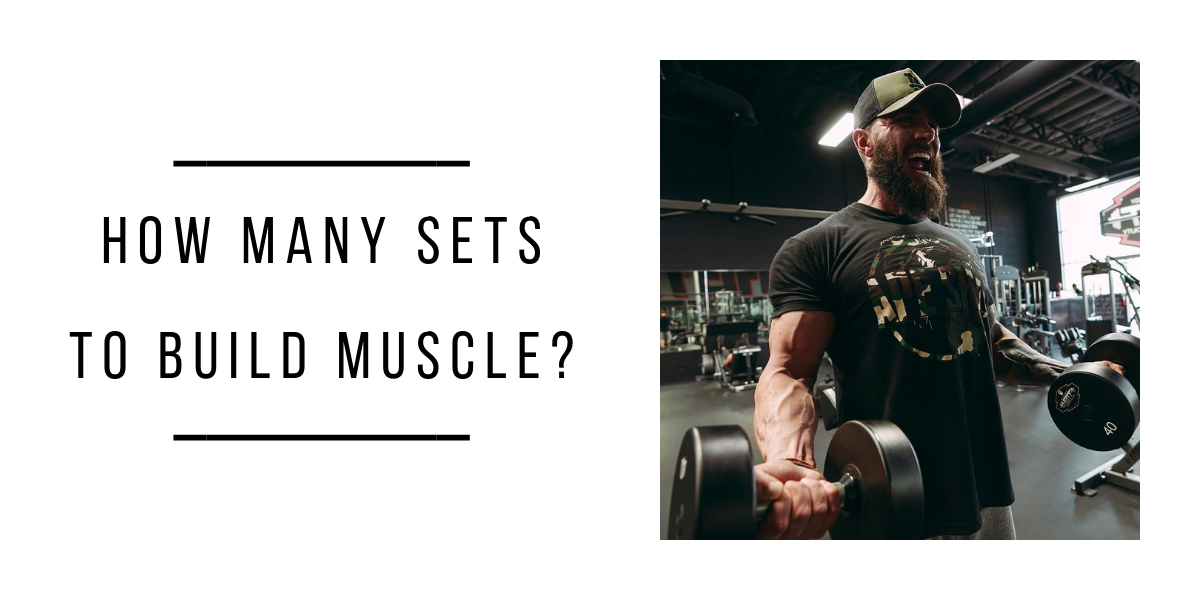If you want to know how many sets you need to perform per week to maximize muscle growth, then you want to read this article.
Generally speaking, muscle building is a relatively simple process that centers on three key concepts:
Do these three things consistently and over time you will build muscle and increase strength.
However, where things get a bit “hairy” is in figuring out the specifics such as “how many calories do I need to eat to build muscle?” or “what is the best training program?”
Another one of the big questions all lifters have is determining the appropriate amount of volume they need to make their muscles grow.
Some subscribe to the philosophy that you should perform the least amount of volume possible it takes to grow (i.e. the bare minimum) and focus on just adding weight to the bar.
In fact, some even believe that all that’s required is one hard set taken to complete and utter failure (and even beyond), a la the high-intensity training philosophy of Arthur Jones, Mike Mentzer, and others.
On the complete opposite side of the spectrum are the high volume proponents who say that the best gains are made when performing lots of sets and reps, capping your weekly volume only when you approach your recovery limit.
Complicating the matter is the fact that both styles do work for building muscle and strength.
The question isn’t which method works, the real question is what is the optimal amount of volume for most people?
This isn’t an easy question to answer as a number of factors go into determining the right amount of volume for each lifter.
Factors such as training experience, age, amount of lean muscle mass, and injury history all play a role in determining the right amount of sets a lifter requires to grow as efficiently as possible.
As you can imagine, there’s not one precise amount of sets every person needs to build muscle all the time.
The good news is, that we don’t have to be as concerned about what is the best rep range to build muscle as research has shown that as long as you’re lifting a weight that is at least 30% of your 1-rep max, you can build muscle...provided you take those lighter loaded sets to failure (or within one rep of failure).[1,2]
So, with the understanding that you will take whatever weight you are using (whether it be lighter or heavier) close to positive (concentric) failure, that means we really only need to focus on how many hard sets we need to perform per muscle group each week to build muscle.
Fortunately, researchers have thoroughly investigated this very issue (how many sets to build muscle) over the past few years and provided the lifting public with a “bare minimum” number of sets that are required to grow muscle as well as a general range that most lifters will respond to best.
How Many Sets Per Muscle Group Do You Need to Build Muscle?
In 2017, a group of researchers led by “the hypertrophy doc” Brad Schoenfeld, Ph.D., compiled all the relevant research (a total of 15 studies) regarding training volume and hypertrophy.
During their analysis, the team documented a “dose-response relationship” between the number of sets a lifter completes and the rate at which his/her muscle grew.[3]
In other words, the more sets a lifter performed, the bigger their muscles grew.
More specifically, Schoenfeld and friends documented that 5-9 hard sets per week yielded better muscle growth than 4 or fewer sets per week and that 10+ sets per muscle group per week yielded even better gains in muscle growth than performing 5-9 sets per muscle group per week.[3]
Therefore, for experienced lifters, it would seem that the “bare minimum” amount of volume you would want to perform to build muscle is at least 10 sets per body part per week.
Inevitably, the next question that pops into anyone’s mind is, “what if I perform more than 10 sets per week? Will my gains be that much better?”
In theory, this would make sense as there is a dose-response relationship between training volume and hypertrophy. Therefore, according to this logic, performing 15 sets per muscle group per week should deliver better muscle growth than performing 10 sets per muscle group per week.
And indeed, that has panned out in the research.[4,5]
So, does this mean you should continually increase your volume, or immediately jump to performing 20+ sets per body part per week?
Absolutely not.
For starters, jumping immediately into a high volume program is a recipe for horrendous muscle soreness and potential overtraining/under recovery.
Additionally, while the research is limited on the upper end of optimal training volume, studies completed thus far indicate an “upper limit” of around 20 hard sets per muscle group per week.[6,7]
The reason for this is that every individual can only tolerate a certain amount of training stress before their stimulus-to-fatigue ratio starts going sideways. In other words, more volume does generally result in more muscle growth, but only up to a certain point. That point, for most lifters, is around 20 sets per week.[7]
Recent High Volume Training Findings
While the 10-20 sets per week range was thought to be the ideal amount for most lifters, recently another study led by Schoenfeld and the “glute guy” Bret Contreras threw everyone in the lifting world for a loop. The latest study found that the upper limit for total weekly training volume per muscle group that a lifter could perform sufficiently while also recovering, avoiding injury, and making gains were 45 sets per week![4]
Does this mean you should start hammering every body part with 45 sets per week?
Again, NO!
Remember this is only one study and lasted just a short amount of time.
What this study does tell us though is that we need not fear training with ultra-high training volumes for brief periods of time, such as during body part specialization routines. Furthermore, this study may also benefit, those “hard gainers” out there that haven’t responded to lower volume training programs and may benefit from performing 20+ sets per week all the way up to 45 sets per week.
So, what can we take away from all of these findings?
The Bottom Line on How Many Sets to Build Muscle
First off, know that there is a dose-response relationship between weekly training volume and muscle growth. Higher training volumes are associated with better muscle growth than low volume approaches.
However, low volume training can build muscle, just not as quickly as higher volume training programs. Therefore, if you are pressed for time and can only get in ~5 hard sets per muscle group per week, realize you’re still making gains, they just might not be as great as if you could perform 10-15 sets per muscle group per week.
Second, based on the available data it appears that between 10-20 “hard sets” per week is the optimal range to maximize muscle growth.
If however, you don’t feel that you are growing with this amount of volume (and you’re already eating enough, sleeping adequately, and limiting other stressors), you can gradually begin increasing training volume by adding a set or two each week to a stubborn body part.
Finally, remember everyone has their own individual volume threshold. Just because two people are roughly the same height, weight, and age as well as have comparable amounts of lean body mass does NOT mean they can handle the same amount of volume.
Start on the lower end of the volume spectrum (10 sets) and gradually increase your volume capacity over time.
References
- Mitchell, C. J. et al. Resistance exercise load does not determine training-mediated hypertrophic gains in young men. J Appl Physiol 113, 71-77 (2012).
- Ogasawara, R., Loenneke, J. P., Thiebaud, R. S. & Abe, T. Low-load bench press training to fatigue results in muscle hypertrophy similar to high-load bench press training. International Journal of Clinical Medicine 4, 114-121 (2013).
- Schoenfeld, B. J., Ogborn, D., & Krieger, J. W. (2017). Dose-response relationship between weekly resistance training volume and increases in muscle mass: A systematic review and meta-analysis. Journal of Sports Sciences, 35(11), 1073–1082. https://doi.org/10.1080/02640414.2016.1210197
- Schoenfeld BJ, Contreras B, Krieger J, et al. Resistance Training Volume Enhances Muscle Hypertrophy but Not Strength in Trained Men. Med Sci Sports Exerc. 2018;51(1):94-103.
- Radaelli, R., Fleck, S. J., Leite, T., Leite, R. D., Pinto, R. S., Fernandes, L., & Simao, R. (2015). Dose-response of 1, 3, and 5 sets of resistance exercise on strength, local muscular endurance, and hypertrophy. Journal of Strength and Conditioning Research, 29(5), 1349–1358. https://doi.org/10.1519/JSC.0000000000000758
- Heaselgrave, S. R., Blacker, J., Smeuninx, B., McKendry, J., & Breen, L. (2019). Dose-Response Relationship of Weekly Resistance-Training Volume and Frequency on Muscular Adaptations in Trained Men. International Journal of Sports Physiology and Performance, 14(3), 360–368. https://doi.org/10.1123/ijspp.2018-0427
- Haun, C. T., Vann, C. G., Mobley, C. B., Roberson, P. A., Osburn, S. C., Holmes, H. M., Roberts, M. D. (2018). Effects of Graded Whey Supplementation During Extreme-Volume Resistance Training . Frontiers in Nutrition . Retrieved from https://www.frontiersin.org/article/10.3389/fnut.2018.00084











Leave a comment
This site is protected by hCaptcha and the hCaptcha Privacy Policy and Terms of Service apply.